“The Eye of the Beholder”
Written by David P. Harmon
Directed by Hal Sutherland
Animated Season 1, Episode 15
Production episode 22016
Original air date: January 5, 1974
Stardate: 5501.2
Captain’s log. The Enterprise is investigating the disappearance of the crew of the U.S.S. Ariel, a six-person ship that was on a scientific mission to Lactra VII. In a briefing, Spock shows Kirk, McCoy, and Scotty the last log entry made by Lieutenant Commander Markel. Half the crew beamed down and disappeared. Markel and the other two beamed down to try to find them. Nobody’s heard from any of the half-dozen crew in six weeks.
While Arex conducts a sensor scan—he has detected several different types of life forms, but no cities or other indications of civilization—Kirk, Spock, and McCoy beam down to the coordinates that Markel and his party transported to.
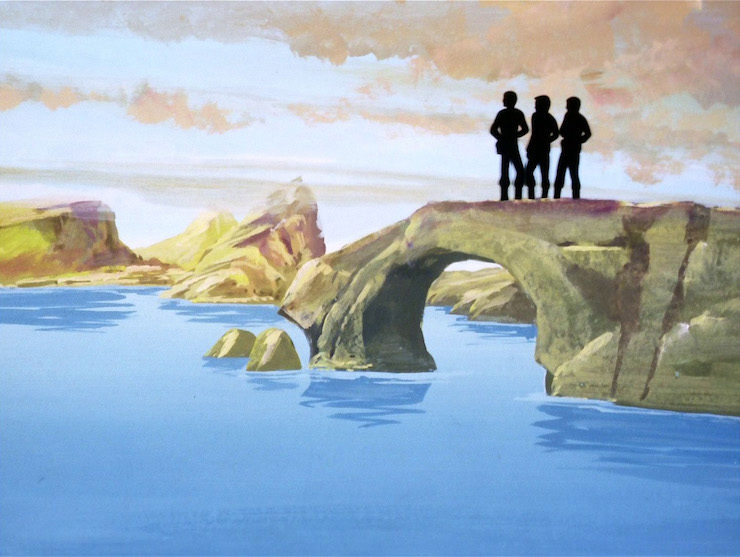
They materialize in an open area near a lake filled with boiling water. A sea monster moves to attack them, but they drive it off with phasers set on stun. Kirk tries to raise the Ariel crew on his communicator, but while there’s no voice response, the communicator does get a signal from one of the Ariel crew.
They trace it, and encounter a large creature that also moves to attack. Once again, phasers are used to drive it off, though it seems to feed on phaser energy rather than be stopped by it. However, it’s vulnerable on the underside of the neck. The good news is that when they focus their fire there, the creature falls over. The bad news is that it falls right on McCoy. Spock and Kirk manage to dig him out, and they proceed to follow the signal.
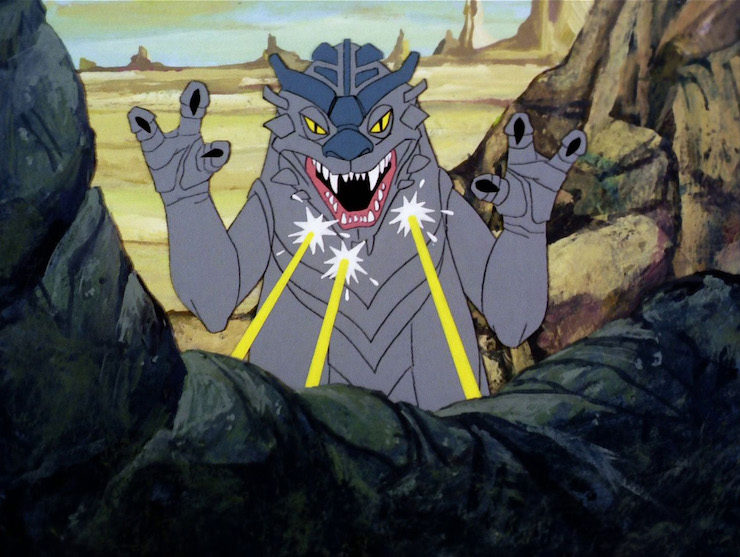
Kirk recognizes the creature as coming from Canopus III, and it’s living in a desert area similar to that world. Shortly thereafter, they’re in a rainforest region, and Spock comments on the oddity of such diverse ecosystems so close together. Scotty reports that there’s what may be a city northeast of them, in the direction they’re already going.
When they reach water, Spock scans it, and it’s far too pure to be natural—he hypothesizes that the differing ecosystems on this world are all manufactured.
They’re attacked by a bunch of dragons similar to those on the planet Maravel, and once again, the landing party use phasers, but they’re completely useless. However, the dragons do seem to hit a force field, which drives them off—but the landing party isn’t exactly safe, as they’re grabbed by large tentacled creatures—the Lactrans—and brought to the city Scotty mentioned.
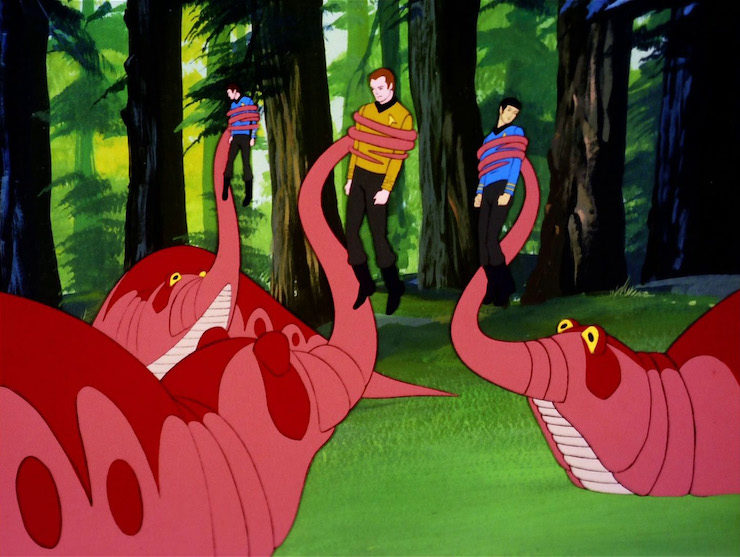
They’re placed inside a cell, and McCoy believes that they’ve been quarantined to make sure they don’t have any harmful bacteria. Spock is able to receive some vague telepathic impressions from the Lactrans, but not much beyond that. He thinks they’re much more advanced than the Federation.
The Lactrans take the landing party from their cell and put them in an environment suited to them. En route, they see a menagerie of alien beings in other small cage-like environments. (Ahem.) Inside, they encounter Markel and another Ariel crew member, Randi Bryce. They confirm that this is a zoo, and they’re the exhibits.

Another of their crew, Lieutenant Nancy Randolph, is ill. McCoy examines her, while Spock tries to make direct telepathic contact with the Lactrans. Unfortunately, the Lactrans’ response is to just laugh at them. (“Aw, look at the cute humanoids!”)
McCoy can’t do much for Randolph without his medikit, so Spock suggests they all think solely about the medikit. Sure enough, the Lactrans sense this and give McCoy the medikit, which is undamaged. While he treats Randolph, Kirk tries to find a weakness in their cage to allow them to escape.
Spock suggests that one of them pretend to be sick and the others think hard about the communicator as a necessary component to heal the sick person. Once they get their hands on a communicator, Scotty can beam them up. Sure enough, this works—to a point. The young Lactran who gave Kirk the communicator grabs it as soon as it realizes that Kirk was tricking them, so Scotty winds up beaming the child to the Enterprise. On the surface, the Lactrans are concerned, as they didn’t view the humanoids as harmful up until now, but they just made their kid disappear.

Immediately, they interrogate Kirk telepathically, trying to find out what happened to the kid. Meanwhile, the kid grabs Scotty and brings him to the bridge, which Scotty orders cleared immediately. The kid figures out all of the Enterprise systems by reading Scotty’s mind, and actually takes the ship out of orbit—but then Scotty convinces the kid that he’s not a pet, and that they should go back to the planet. They beam down, and in the nick of time, as the Lactrans were coming very close to burning out Kirk’s brain trying to find out what happened.
The Lactran adults are very glad to have their kid back, while the kid tells them all about the Federation. The Lactrans realize that the two landing parties are sentient, and therefore don’t belong in a zoo, though they’re still pretty laughably primitive by the Lactrans’ standards. They let them go, and say to come back in twenty or thirty centuries.
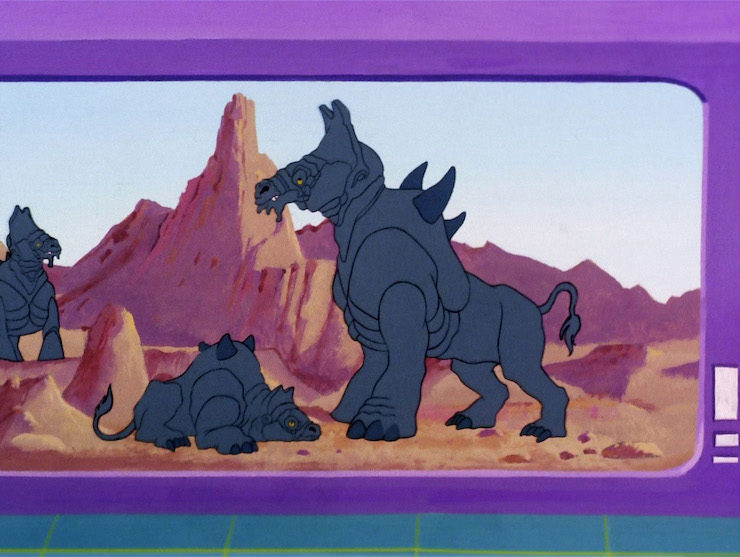
Can’t we just reverse the polarity? Spock says the communicator signal is 1.1 kilometers away, but Scotty later says the city (where the signal originated) is 98.5 kilometers away. Scotty also reports that the city is to the northeast, but the Lactrans take the landing party northwest to the city. Nice to see D.C. Fontana was putting that script editor title to good use…
Fascinating. Spock goes on at great length about how intelligent the Lactrans are, then suggests that they might fall for the sick-prisoner trick. Sure.
I’m a doctor, not an escalator. McCoy spends the entire episode bitching and moaning and picking fights with Spock for no reason except that McCoy’s supposed to do that.
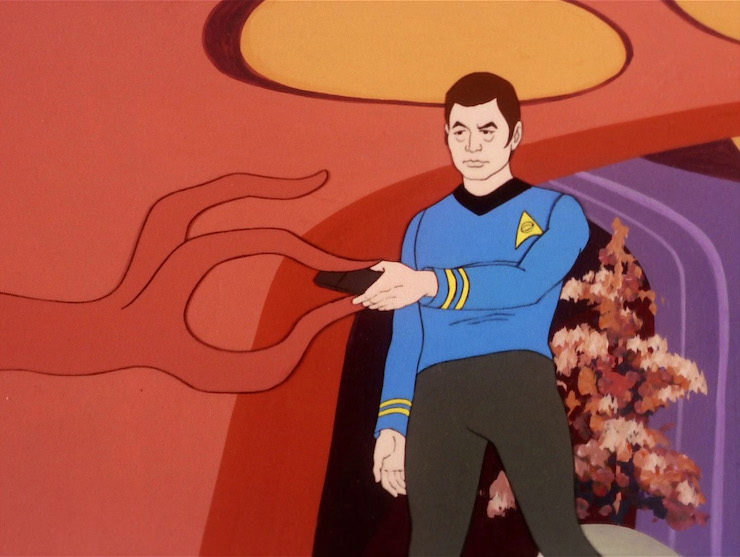
I cannot change the laws of physics! Scotty saves the day here, as he actually makes significant contact with the kid and enables everyone to finally talk to each other.
Hailing frequencies open. M’Ress is at communications this week, though she’s only on screen long enough to follow Scotty’s order to clear the bridge.
Channel open. “Doctor, your lack of scientific interest is amazing.”
“I’ll be happy to discuss that that with you, Mr. Spock, next time you drop into my medical lab.”
Spock insulting McCoy and McCoy explaining why it’s a remarkably stupid insult.
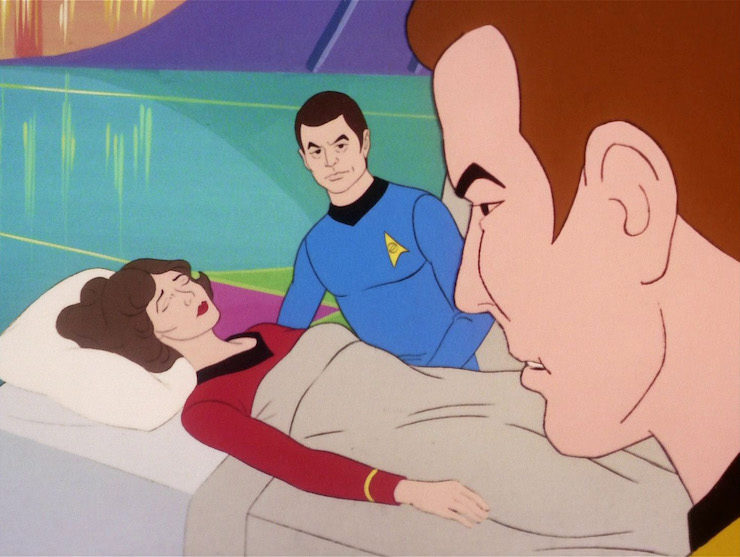
Welcome aboard. This is another episode that only uses James Doohan and Majel Barrett for additional voice work—I guess George Takei and Nichelle Nichols got a week off after being so prominent in “The Slaver Weapon“—so Doohan does Scotty and Markel while Barrett does Bryce and M’Ress.
Trivial matters: David P. Harmon also wrote “The Deadly Years” and co-wrote “A Piece of the Action.” He was reportedly less than happy with this episode, mostly because he thought animation couldn’t convey the depth necessary for a good Trek story.
The U.S.S. Ariel was likely named after the character in The Tempest by William Shakespeare.
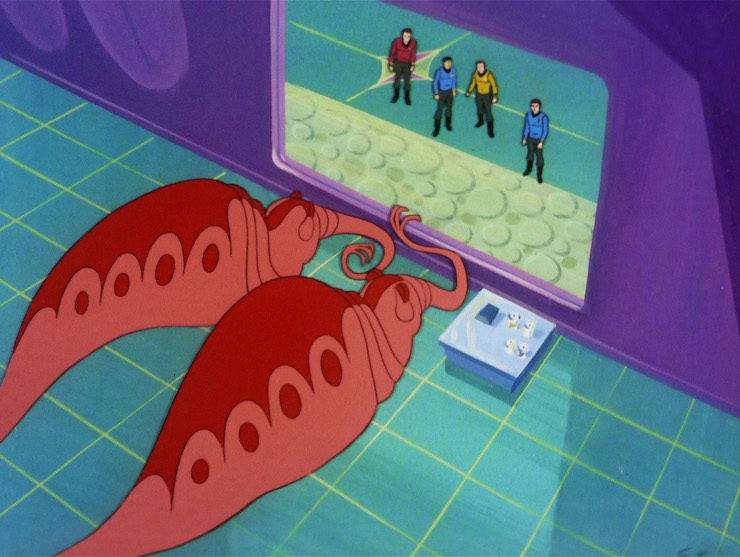
The series of small enclosures filled with alien creatures that the Lactrans bring the landing party past on the way to the humanoid enclosure is very reminiscent of the similar enclosures used by the Talosians in “The Cage.”
To boldly go. “We are considered simplistic, but in the process of evolving into a higher order.” There’s a good episode to be made from this premise, but the actual script is a tremendous mess. Distances and directions change from line to line, the initial science team beamed down from the Ariel yet the ship is inexplicably never seen, and Spock and McCoy’s bickering has never felt so forced and unnecessary.
Worse, Randolph, the sick Ariel crew member, is introduced and then forgotten about. We never find out if McCoy made her better or not, and even worse, they concoct a plan that requires a sick prisoner and they have a sick prisoner right there! Yet Kirk decides to pretend to be sick instead! What the heck????
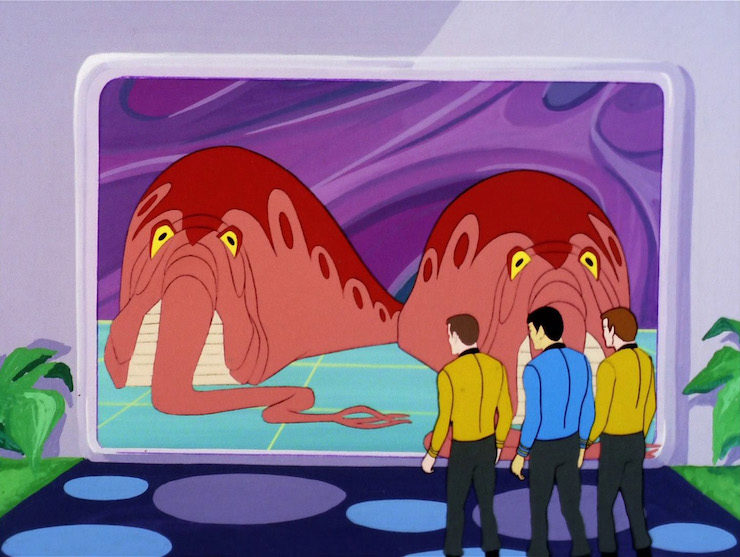
On top of that, William Shatner’s overacting sounds even worse here when he’s resisting the Lactrans’ telepathic contact than it does in live-action, where at least he can sell it to some extent with body language. Here, he just sounds like he’s reading the script very very badly.
Which is too bad, because there’s some good stuff here. In particular the episode is one that works far better as an animated episode, as the aliens are far more alien (though the dragons are just a reuse of the swoopers from “The Infinite Vulcan“), and the Lactrans in particular are very distinctive, and not really possible to do on a 1970s live-action budget, but easy enough to do justice to even with Filmation’s limited animation.
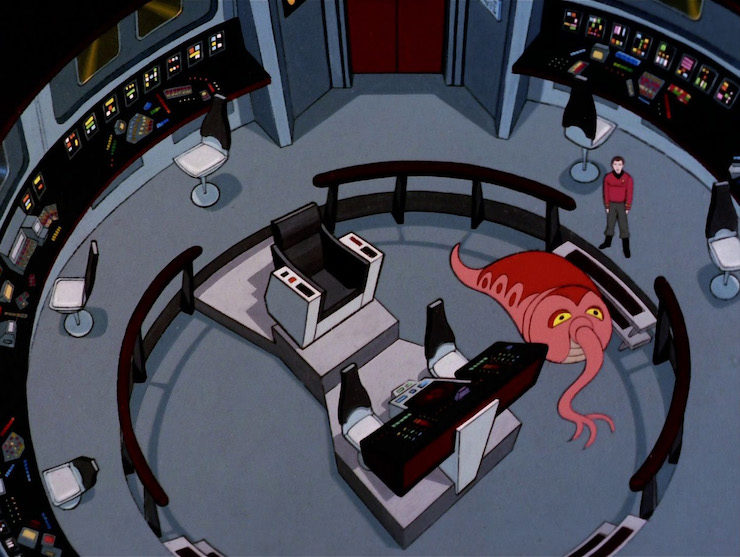
I also love the fact that the day is saved by a six-year-old kid who doesn’t have the adults’ preconceived notions and is therefore open to actually talking to the “animals” rather than just laughing at their silly antics.
Still, it’s obvious that Harmon didn’t put his best effort into this—he is on record as being unimpressed with animation as a storytelling medium for Star Trek, and that disdain shows in the slapdash nature of the script—and it seems that rewrites weren’t in the budget for this one. Either that, or it was rewritten and this is the improved version, which is even scarier. A grave disappointment either way.
Warp factor rating: 4
Next week: “The Jihad”
Keith R.A. DeCandido will be a guest at I-Con 32 this weekend in Brentwood, New York, alongside fellow Trek scribes David Gerrold, Peter David, Christopher Golden, and Glenn Hauman, as well as Cory Doctorow, Daniel Knauf, Cecil Baldwin, Rikki Simmons, Pamela Gay, and tons more. You can find his schedule here.










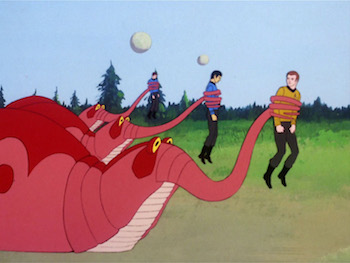
I’m not sure if I want my own baby Lactran as a pet, or it would keep me as a pet.
There’s a difference between intelligence and being exposed to our fantastic collection of bad TV shows!
Meredith: You mean the historical documents?
—Keith R.A. DeCandido, never passing up a chance for a Galaxy Quest joke…..
I also noticed the distance and direction errors. I was willing to handwave the distance issue as a signal coming from closer than the actual settlement (later blown by the fact that they heard the signal from their pen in the zoo), but I actually screamed at the screen when the direction switch happened.
I agree that there’s promise with this episode. The aliens feel more alien than anything that they could have done in The Cage, and as KRAD pointed out, a child without the preconceived notions of his elders decides to communicate with the exhibits, much like a terrestrial child talking to the family dog. In this case, though, unlike the dog, the crew actually communicates back in a way that is understandable to the child.
And KRAD @2 – By Grabthar’s Hammer, there’s always room for a good Galaxy Quest joke.
These are easily the best new aliens created for TAS. A laughing Lactran will cheer me up any day.
I like this one for the premise, despite the flaws in the execution. It is implausible that a people as advanced as the Lactrans wouldn’t understand a transporter beam or be aware of the ship in orbit (how else did these “animals” get to their planet?), and it’s odd that Scotty saved the day off-camera. But it’s nice to see such exotic aliens (even if it’s hard to explain how the Lactrans could build such an elaborate civilization with only one manipulative limb each), and to see a hyper-advanced race that, for once, isn’t a glowing ball of light.
Keith, Spock doesn’t say the communicator signal is 1.1 kilometers away, just that it’s the distance to the edge of the desert.
This is one of the four episodes that Alan Dean Foster expanded to novel length by adding a new plot, in Star Trek Log Eight in this case. His sequel story involved the Lactrans getting the crew’s help in capturing a giant, warp-capable extragalactic creature called a jawanda (basically a flat sheet as wide as a planet but only millimeters thick, to maximize its energy collection area). Whereas his other sequel stories picked up after the end of the episode (or before, during, and after it in the case of “The Slaver Weapon”), he actually changed the ending of this episode significantly to set up the continuation, with the Lactrans insisting on the crew’s help with the jawanda before agreeing to let them leave, and beaming several of their number aboard the Enterprise with the rest.
Because of that discrepancy, this is the one TAS episode for which I bought the script and storyboard copies offered by Lincoln Enterprises. Back before the home video release of TAS, that was the only way I could find out how the episode originally ended. As such, I’m now able to compare the script to the finished episode and see some discrepancies:
First, there’s an odd non sequitur in the transporter room scene:
That doesn’t make any sense. But in the script, Scott’s line about life forms came before Kirk’s line about coordinates, after which Scott said, “Begging your pardon, sir, but if I beam you down in the same place, you could end up in the same kind of trouble.” Which is what Kirk’s “beam back up” line was supposed to respond to.
Spock’s line “The desperation of the science ship’s first landing party is now obvious” sounds a bit incongruous, since it comes at a calm moment some time after the dinosaur attack. Originally, there was to be another animal attack just before it, from “a pack of six feet high, saber-tooth wild dogs” with “four legs and antennas.” (As if dogs with four legs were unusual…?) Kirk ordered the others to go hide in a nearby cave, but a two-headed python emerged from it. The trio dove into the underbrush, then backed slowly away as the dogs and the python attacked each other, prompting Spock’s line about desperation. I’m guessing they cut this sequence because it would’ve been harder to animate than the other attacks. It is included in Foster’s version, though (there’s actually a chapter-ending cliffhanger when they’re caught between Scylla and Charybdis, so to speak).
Harmon’s script also said that the Lactrans’ tails were their manipulative organs, rather than their probosces. Foster’s adaptation makes the same assertion; I’d assume he only had the script to work from. There’s some extra chatter at the start of Act 2, with Kirk and Spock discussing whether these are intelligent life forms (Spock getting his tricorder snatched confirms it) and McCoy saying “I still have the feeling I’m about to become someone’s lunch,” to which Spock replies, “For a creature of this size, Doctor, you are hardly more than an appetizer.” McCoy quips that that’s a comforting thought.
McCoy’s line “Well, so much for mythology” and Spock’s reply “I find them strangely attractive” were intended to be in response to a zoo section “devoted to open plains and unicorns,” rather than the random weird critters we got. Although the unicorn drawn in the storyboard has the body of a buffalo.
The Lactrans’ quivering “laughter” in the script was in response to Spock using a twig to write “a complicated formula on the ground,” rather than the telepathic attempt immediately prior. Kirk is confused because mathematics is a universal language, but Spock says they’re so far ahead that “it’s as though I were trying to make words out of children’s building blocks, and failing.” He had no more luck with chemical formulae.
After they get the medical kit, there’s a line clarifying that the force field is back up, and then a brief cut to M’Ress telling Scotty she can’t raise the landing party and Scotty telling her to keep trying. Easy to see why they cut that. When Markel then gives his assessment to Kirk, he reports, “We’ve worked out our own calendar according to the artificial sun and moon they’ve given us” and that they draw a large crowd every nine Earth days, presumably the Lactrans’ weekends (or as Spock puts it, “Probably a recreation or rest period”). Before Spock’s act-ending line about facing the situation realistically, there’s a longer exchange where he says he’s not prone to “fanciful dreams,” Markel says “I never met a Vulcan who was,” and Spock says “I hope that was meant to connote the value of being a Vulcan,” with Kirk defusing it with “It was.”
At the start of Act 3, McCoy insists he won’t do tricks for the spectators. Randi says they’ve been given a pool and exercise area, and there’s a discussion of how eating, sleeping, and playing is all that humans expect of zoo animals. McCoy insists, “I am not an animal!” Spock begins, “Scientifically speaking…” before Kirk interrupts with the line from the final episode about trying to learn from the Lactrans.
After Scotty beams up the Lactran, he calls security, and we get one more beat of an alien being unaffected by phasers on stun (and it’s ridiculous how they keep making a point of “phasers on stun” and never even consider a higher setting).
There are a few other single lines cut, mostly not worth mentioning, but when Scotty says farewell to the Lactran child, he reels a bit from its telepathic reply and says, “He shakes hands like a man.”
So let me get this straight. The Ariel has a crew of six and they all beam down to the planet. How exactly were they gonna get back to it?
“Spock goes on at great length about how intelligent the Lactrans are, then suggests that they might fall for the sick-prisoner trick. Sure. “
Given that the Lactrans are basically zoo-keepers and that zoo animals never pull off these kinds of tricks, its hardly surprising that they don’t see right thru it. Try moonlighting as a prison guard sometime without any training and see how many tricks the prisoners pull that wouldn’t work with a more experienced guard.
ragnarredbeard: The ship’s computer could beam them back up.
—Keith R.A. DeCandido
@8/krad: We’ve certainly seen computers able to initiate transport in the 24th century (runabouts in DS9 were often left vacant in orbit), but I’m not sure that capability was established in the 23rd. In “This Side of Paradise,” it was assumed that, if Kirk did beam down and leave the ship empty, there would be no coming back.
We did see in “The Terratin Incident” that the transporter could be manually programmed to initiate an automatic return transport after a set interval, though. Maybe Markel, Bryce, and Randolph programmed it to beam them up after a certain length of time, maybe a few hours, but they were captured by the Lactrans and carried out of the region the transporter was programmed to scan. Or maybe the transporter was automatically tracking their communicator signals but lost them once they were within the Lactrans’ force fields.
6. ragnarredbeard
The same way as the crew of the Sulaco in Aliens, once their only dropship pilot was killed on the surface?